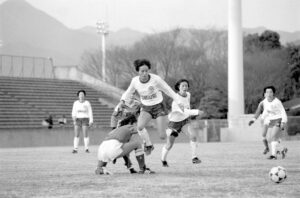“History of the Nadeshiko League”5. Beleza the “Frontrunners”
From the time when it was still unusual for women to play football, through to the birth of the Japan Women’s Football League, victory in the Women’s World Cup, and creation of the Japan Women’s Empowerment Professional Football League, social conditions and the environment surrounding girls’ and women’s football have undergone great changes.
We intend to publish a series of 22 articles before the end of the year in which we will look back over the tempestuous history of girls’ and women’s football in Japan.

After losing to Shimizu FC in the final game to be deprived the honor of being inaugural champions of the Japan Women’s Football League (the current Nadeshiko League) held from September 1989 to January 1990, Yomiuri SC Ladies Beleza raised its game in an effort to avenge this defeat.
In the second year of the league held from April 1990 to January 1991, the same six teams played each other three times instead of two as in the previous year. This meant that each team played 15 games, representing an increase of 1.5 times over the first season. Beleza stormed to the title after winning 14 and drawing one of its 15 games. Apart from one drawn game with the renamed Suzuyo Shimizu FC Lovely Ladies, the previous season’s champions, Beleza won every game and finished seven points (11 points based on the current points system) ahead of Shimizu.
The season MVP and top scorer with 16 goals was Akemi Noda. With Noda as captain, Beleza had a formidable lineup that included other Japan national team players such as Asako Takakura, Takako Tezuka, Midori Honda, and Tomoko Matsunaga. These five players also featured in the Asian Games that were staged in Beijing in September. Japan were beaten by the eventual champions China, however, it overcame the powerful North Korea team to win the silver medal and give some cheer to the people who had worked so hard to get the Japan Women’s Football League off the ground.
Beleza had been founded in 1981 by Ryoichi Aikawa, the manager of Yomiuri Soccer Club, which was becoming a powerhouse on men’s football. Not representing a company or an educational institution, the team had to start from player recruitment, however, it had a strength in that it owned its own training ground inside “Yomiuri Land” in the west of Tokyo. In the team’s second year, Akemi Noda joined as a first grade junior high school student, and the team grew stronger by leaps and bounds under the guidance of Kazuhiko Takemoto, who became manager in this year. Between 1984 and 1988, Beleza won the Tokyo Women’s Football League for five consecutive years, and in the 1987-1998 season (March 1988), it won the Empress’s Cup JFA Japan Women’s Football Championship for the first time when it beat Shimizu Daihachi, which had been champions for seven consecutive years previously.
Considering this, there is no doubt that Beleza were bitterly disappointed at losing the championship to Shimizu FC in the first season of the Japan Women’s Football League that started in1989. After becoming champions in the second year, Beleza won a second consecutive title with 16 wins and two draws in the third year of the league in 1991, when the number of teams was increased to 10. This was the season in which Homare Sawa made her debut as a junior high school first grader. Beleza also won the league in the fourth year with 16 wins and two draws. It went a record 51 games unbeaten over three seasons. It lost to Suzuyo Shimizu in an upset on the opening day of the fifth year of the league in 1993, however, after winning all of its games in the second stage of the season, the team became champions for the fourth year running.
Around this time, there was a rapid increase in the number of overseas players, including world-class players, in the Japan Women’s Football League, and the level of the women’s game improved dramatically. Some teams were run professionally by large corporations, while other teams started paying players bonuses for winning. In these circumstances, after winning the title for the fourth time, Beleza missed out on the championship for a spell. Even so, Beleza didn’t stop being the focal point of the league.
Beleza’s performance was underpinned by “youth development”. The club quickly launched its development team, “Menina”, in 1989 and continued to select and thoroughly train talented players of junior high school and senior high school age. Such an approach had already brought success to the men’s team. Rather than assembling ready-made players, the approach of patiently nurturing players from an early age proved valuable. Indeed, Beleza’s youth team eventually came to account for almost half of the players in the Nadeshiko Japan national team.
Over 32 seasons of the Japan Women’s Football League (the current Nadeshiko League), which was Japan’s top league for women’s football, between 1989 and 2020, Beleza achieved remarkable success by becoming champions 17 times and runners-up 12 times.
It is no exaggeration to say that the hard work of Beleza in preserving its status as the top team, and the efforts made by other teams in trying to catch and overtake Beleza, underpinned the formation of the Nadeshiko League and development of women’s football in Japan.
Yoshiyuki Osumi (football journalist)






